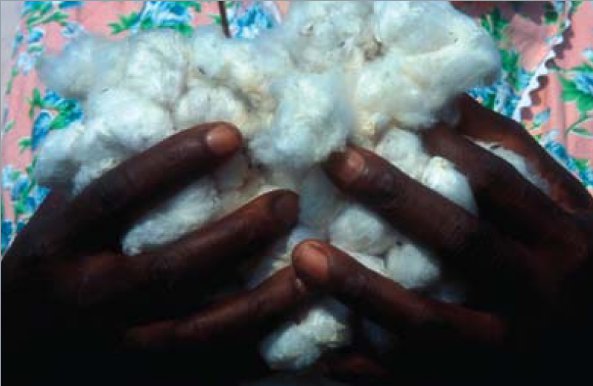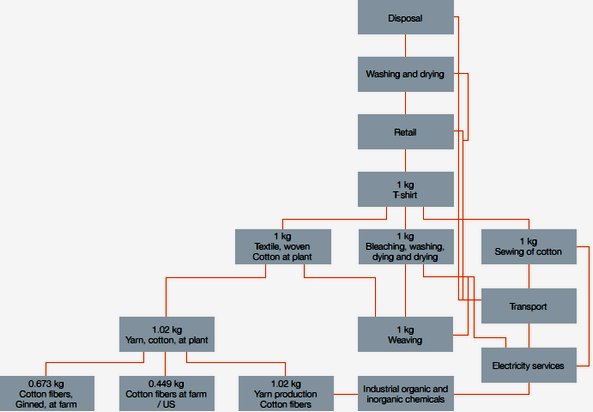It used to be that when consumers had to choose between two similar products, it was a pretty easy decision to make: just weigh the benefits of cost and quality then pick the item and brand that suited your needs. Today, the choices are many, and more difficult. Buyers are now drived to be conscious of the effects their choices have on our environment and on the local economies. Do we buy from the farm stand or the supermarket? Which choice will result in a less polluted, more sustainable globe? Perhaps even more daunting is the fact that some of our choices will have social and socio-economic effects as well, not only on workers but also on entire communities where production takes place. These social and socio-economic consequences are the primary concern of a social and socio-economic life cycle assessment (S-LCA).Life cycle assessments, until now, have generally been used to analyze the effects that a product or process will have on the environment. Results of an LCA study will let companies know which aspects of their production are efficient, and where they can improve efficiency to reduce environmental impacts. All stages in the life cycle of the product are considered in an LCA, from the mining and extraction of its raw materials, to the shipping, right on to the landfill. Data are not only considered for the initial product, but also for the full life cycles of other materials that are used in the making of the product. Social and socio-economic life cycle assessments add extra dimensions of impact analysis, valuable information for those who seek to produce or purchase responsibly.
 Take, for example, a simple cotton T-shirt. First, let’s imagine that Shirtz—a hypothetical retailer—has requested an LCA of their latest product: a package of white undershirts. Shirtz Inc. wants to know how this new item will affect its environmental footprint as a corporation as well as what sort of improvements they can make to the production of the shirts that will reduce emissions and other harmful environmental outputs.
Take, for example, a simple cotton T-shirt. First, let’s imagine that Shirtz—a hypothetical retailer—has requested an LCA of their latest product: a package of white undershirts. Shirtz Inc. wants to know how this new item will affect its environmental footprint as a corporation as well as what sort of improvements they can make to the production of the shirts that will reduce emissions and other harmful environmental outputs.
Furthermore, Shirtz wants to know what sort of social and socio-economic effects these shirts will have on their workers, and on the communities where they have shirt factories. As an already established company, Shirtz is legally held to minimum benchmarks for things like workers’ rights but they want to take their social responsibility further and need guidance on how to proceed. The label “Fair Trade” is limited in scope and ignores huge sections of the life cycle. While the making of their shirts may be ethical, the company wants to know if this can be true for the entire life cycle, even phases like shipping and disposal. These specifications and questions will help the analysts focus on finding data relevant to the goals of Shirtz.
 Shirtz will work in cooperation with the analysts to determine what sort of data will be required to do the study. What kind of emissions to the air, water, or land will the study take into account? The list of chemicals released into nature during the production of the shirts probably numbers in the thousands, some more potent and detrimental than others. Special attention will probably be paid to outputs like carbon dioxide and other greenhouse gases. In parallel, the analysts will inform Shirtz on which phases of the life cycle of the product might have the greatest share of worker hours and furthermore, for which phases of the life cycle the social impacts may be the most important, using secondary data.
Shirtz will work in cooperation with the analysts to determine what sort of data will be required to do the study. What kind of emissions to the air, water, or land will the study take into account? The list of chemicals released into nature during the production of the shirts probably numbers in the thousands, some more potent and detrimental than others. Special attention will probably be paid to outputs like carbon dioxide and other greenhouse gases. In parallel, the analysts will inform Shirtz on which phases of the life cycle of the product might have the greatest share of worker hours and furthermore, for which phases of the life cycle the social impacts may be the most important, using secondary data.
Third, the analyst will consider all the data found on the shirts, taking into account each and every piece and process involved in the making of the product, as much as can be acquired. The impacts of the gathering and shipment of raw cotton to a textile company, of refining that cotton into a fabric that can be sewn into shirts, the dyeing of the fabric, the stitching, the printing and addition of those uncomfortable tags that go on the necks of the shirts that say “Shirtz” in little red letters—each part is factored in. But this is just the first step. Analysts then need to consider the impacts of the life cycles of the red dyes, threads, and nylon label tags up until the point at which they enter the life cycle of the T-shirt itself. By the end of the study, analysts will have data that can tell Shirtz exactly how much carbon dioxide is produced for each shirt they make. As much as they can, the analysts will also try to find the information on the location where each of the inputs were made and how they were transported.
But that is just the easy part. Environmental impacts are much more easily standardized and quantified than social and socio-economic ones, for obvious reasons. Things like emissions can be readily measured and given numerical data that can be used over and over. For example, life cycle analysts can access data that will tell them the emissions of a freight truck. All that is left is for Shirtz to let them know how far they ship their product.
——————————————————————————————————–
Process chains detail the series of operations performed in the making, treatment, use and disposal of a product. Process chains may be built based either on process data or economic input-output data supplemented with environmental data, or both. The economic input-output method considers an entire
economy – all activities of all industry sectors– but the processes are relatively aggregated. On the other hand, the process method offers detailed information on specific processes but important parts of the product systems may be left out because of the difficulty of following the entire supply chain in detail. The product system, made of the process chains, is usually depicted in a process flow chart. The process flow chart shows the main sequence of production, with a varying level of detail: from resource to product to waste. The system must also include energy and ancillary materials (input) that support the main production, and the production of all the input themselves. If all the loops are left out, the product life cycle flow chart can be made to resemble a tree with many roots and branches. Because the focus of the assessment in S-LCA is the product, it is necessary to build the product system. Economic and/or physical relations seem best suited to define and detail what the product system consists of.
Figure 7 – Representation of a product system
——————————————————————————————————————–
However, S-LCAs are surely as important as environmental ones. That being said, how can we proceed to conduct a S-LCA? How do we collect the data? How can we begin to assess and measure the social effects of a T-shirt? How do we assign a result or a number to the working conditions in shirt factories, or the ways in which a shirt factory affects the residents of a small community? How do we define a socially responsible company or practice? How do we bring the results for every phases of the life cycle together?
These are the questions asked and to which these guidelines for social life cycle assessment of products bring relevant answers.
One core issue with S-LCA is keeping consistency among the standards between studies. Even if standards can eventually become more or less similar in criteria, differences among studies will always occur. Generally, practitioners of S-LCA will need to incorporate a large share of qualitative data, since numeric information will be less capable of addressing the issues at hand. When numeric data is useful – for example, in assessing the wages of a particular enterprise – additional data will still be needed to address its meaning: compliance with minimum wage laws does not always mean the wages are livable. Often, data may have to be collected on the spot, since databases for specific social and socio-economic impacts are at a minimum.
As one might guess, the current limitations of S-LCA are many. They can be expensive, if extensive data gathering is required. They are challenging to conduct because qualitative data is often subjective and therefore must be handled by capable experts. As with environmental LCAs (E-LCA), the ripple effects in the life cycle of the product are difficult to determine. It is hard to see where the effects of social interaction finally diminish. Since the scope of the studies is quite large, it is impossible to truly assess the entire life cycle. A T-shirt is a complex product with many inputs from different places. Dyes, fabrics, threads, and all their separate parts—they all have their own intricate life cycles full of inputs of their own. Without declaring boundaries, deciding where the inputs become negligible, the studies would be near impossible. The same is true for S-LCA. Furthermore, since social LCAs are almost always requested by companies and not those employed by them, they may not always have the best interests of the socially affected people at heart.
Still, while the difficulties of conducting a S-LCA are indeed many, at the end of the study, Shirtz will have a wealth of invaluable information. The company will be able to know, in terms of labor, the share of its entire life cycle worker hours that possesses a range of attributes. How much of this labor is child labour free? Do Shirtz’s practices – and the practices of all its T-shirt inputs – comply with, exceed, or fail to meet standards for human rights, working conditions, health and safety, and socio-economic repercussions?
The study will provide detailed answers. Shirtz will be able to communicate this information to its retailers and consumers via reports, web interface, or by putting tags on its products. The information collected will help the enterprise work to improve its social performances on key issues or in problem areas that have been identified in the study as needing improvement. It will also start dialogue for improvement in the supply chains. Shirtz will now know much more in depth the social impacts of its T-shirt, from cradle to grave.
But what Shirtz actually does with this information brings up the question of corporate social responsibility, or CSR. What sort of obligations do corporations have towards customers, communities, employees, or suppliers? Current CSR definitions and theories hold that companies should, at the very least, be held to international standards of human and workers’ rights, and that they should consider environmental output regulations when making corporate decisions. Still, implementation of CSR is relatively new and poses complex challenges. How can we hold companies to a standard of ethical decision-making? How can we give motivated companies the opportunity and tools with which to productively exceed the current standards of CSR?
As further research will be conducted in the field of CSR and S-LCA, and further negotiation occurs among countries and with their companies, it may be possible to obtain more precise guidance on socially acceptable production methods, and to provide recommendations for setting system boundaries. There is also a great need for better databases of social and socio-economic information as well as the development of software tools that will speed up the process and help analysts conduct the studies. There is a need for ways for anyone – consumer, worker, citizen – to obtain information on a product’s life cycle impacts and therefore, a company’s production methods.
But in the end, if companies are not held responsible by their consumers, these questions of social responsibility are difficult to answer. Inevitably, the accountability lies with the people who will be wearing the T-shirts and their desire to support a socially responsible corporation.

